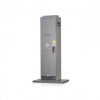What is Power Factor?
All inductive loads require two types of power to function properly:
- Active power (kW) performs real work in loads such as motors
- Reactive power (kVAR) is consumed by inductive loads such as AC motors and performs no productive work
Power Factor is the ratio between the active power and the total power consumed (apparent power or kVA) and is the standard measure of how efficiently electrical power is being used by a system.
Why Improve Power Factor?
When the power factor is below 1.0 or unity, the electrical efficiency of the system decreases forcing the utility to supply more apparent power than necessary.
Utilities can pass on the resulting costs to the industrial users as power factor penalties and high utility bills.
Issues caused by low power factor may include:
- Poor system performance
- High energy costs
- Electric surcharges
- Harmful environmental impacts
Powerful Features
The PF Guard offers an automatic switching design, providing an optimized solution for your application. A detuned, anti-resonance reactor is built into the unit for an extra layer of protection from harmonics and to prevent equipment failure, reduce costs and increase the life of the system.




